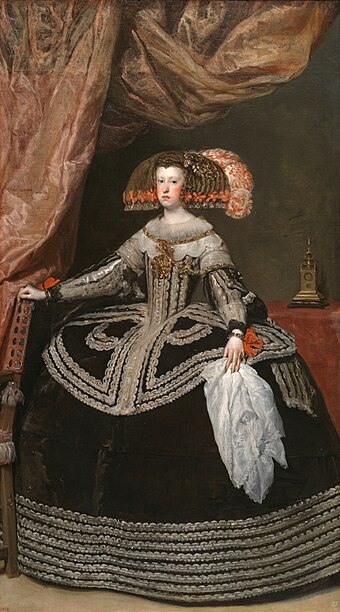| Portrait of Mariana of Austria | |
|---|---|
 | |
| Artist | Diego Velázquez |
| Year | 1652–1653 |
| Medium | Oil on canvas |
| Dimensions | 234.2 cm × 131.5 cm (92.2 in × 51.8 in) |
| Location | Museo del Prado, Madrid |
Portrait of Mariana of Austria is a 1652–1653 oil-on-canvas painting by Diego Velázquez, the leading artist of the Spanish Golden Age, existing in a number of versions. Its subject, Doña Mariana (known as Maria Anna), was the daughter of Emperor Ferdinand III and Maria Anna of Spain. She was nineteen years old when the painting was completed. Although described as vivacious and fun-loving in life, she is given an unhappy expression in Velázquez's portrait. The portrait is painted in shades of black and red, and her face is heavily made up. Her right hand rests on the back of a chair, and she holds a lace handkerchief in her left hand. Her bodice is decorated with jewellery, including a gold necklace, bracelets and a large gold brooch. A clock rests on scarlet drapery behind her, signifying her status and discernment.
Mariana had been betrothed to her first cousin, Prince Baltasar Carlos. He died in 1646 aged sixteen, and in 1649 she married her uncle, Baltasar Carlos's father, Philip IV, who sought her hand so as to preserve the hegemony of the Habsburg dynasty.[A] She became queen consort on their marriage, and after her husband's death in September 1665, regent during the minority of her son, Charles II, until he came of age in 1675. Owing to Charles' inhibiting physical weaknesses, she dominated the political life in Spain until her death in 1696.
Velázquez completed a series of portraits of the Spanish royal family in the 1650s.[2] The paintings are marked by an emphasis on bright hues against dark backgrounds, extravagant head-dress, and fashionably wide dresses. The series culminates with the 1656 Las Meninas, which includes Mariana and, at center-stage, her daughter the Infanta Margarita Teresa. Three full-length versions of the Portrait of Mariana of Austria survive, as well as half-length variants. The version now in the Museo del Prado is known to be the original, having been in the Spanish royal collection since its completion. Its date is based on a matching description of a canvas sent to Ferdinand in Vienna on 15 December 1651.[3][B]
Cite error: There are <ref group=upper-alpha> tags or {{efn-ua}} templates on this page, but the references will not show without a {{reflist|group=upper-alpha}} template or {{notelist-ua}} template (see the help page).